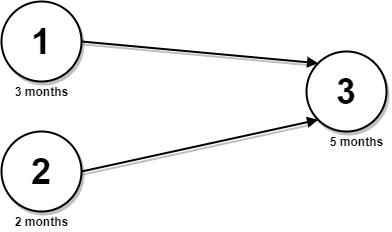
g2001_2100.s2050_parallel_courses_iii.readme.md Maven / Gradle / Ivy
Go to download
Show more of this group Show more artifacts with this name
Show all versions of leetcode-in-java Show documentation
Show all versions of leetcode-in-java Show documentation
Java-based LeetCode algorithm problem solutions, regularly updated
The newest version!
2050\. Parallel Courses III
Hard
You are given an integer `n`, which indicates that there are `n` courses labeled from `1` to `n`. You are also given a 2D integer array `relations` where relations[j] = [prevCoursej, nextCoursej] denotes that course prevCoursej has to be completed **before** course nextCoursej (prerequisite relationship). Furthermore, you are given a **0-indexed** integer array `time` where `time[i]` denotes how many **months** it takes to complete the (i+1)th course.
You must find the **minimum** number of months needed to complete all the courses following these rules:
* You may start taking a course at **any time** if the prerequisites are met.
* **Any number of courses** can be taken at the **same time**.
Return _the **minimum** number of months needed to complete all the courses_.
**Note:** The test cases are generated such that it is possible to complete every course (i.e., the graph is a directed acyclic graph).
**Example 1:**
****
**Input:** n = 3, relations = [[1,3],[2,3]], time = [3,2,5]
**Output:** 8
**Explanation:**
The figure above represents the given graph and the time required to complete each course.
We start course 1 and course 2 simultaneously at month 0.
Course 1 takes 3 months and course 2 takes 2 months to complete respectively.
Thus, the earliest time we can start course 3 is at month 3, and the total time required is 3 + 5 = 8 months.
**Example 2:**
****
**Input:** n = 5, relations = [[1,5],[2,5],[3,5],[3,4],[4,5]], time = [1,2,3,4,5]
**Output:** 12
**Explanation:** The figure above represents the given graph and the time required to complete each course.
You can start courses 1, 2, and 3 at month 0.
You can complete them after 1, 2, and 3 months respectively.
Course 4 can be taken only after course 3 is completed, i.e., after 3 months. It is completed after 3 + 4 = 7 months.
Course 5 can be taken only after courses 1, 2, 3, and 4 have been completed, i.e., after max(1,2,3,7) = 7 months.
Thus, the minimum time needed to complete all the courses is 7 + 5 = 12 months.
**Constraints:**
* 1 <= n <= 5 * 104
* 0 <= relations.length <= min(n * (n - 1) / 2, 5 * 104)
* `relations[j].length == 2`
* 1 <= prevCoursej, nextCoursej <= n
* prevCoursej != nextCoursej
* All the pairs [prevCoursej, nextCoursej] are **unique**.
* `time.length == n`
* 1 <= time[i] <= 104
* The given graph is a directed acyclic graph.© 2015 - 2024 Weber Informatics LLC | Privacy Policy